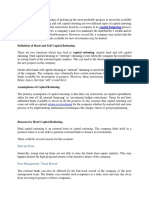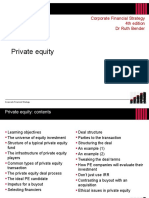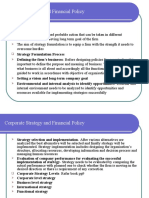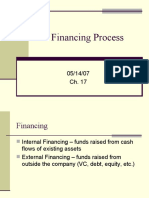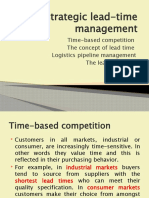Growth Companies Marketing Focus: Corporate Financial Strategy
Growth Companies Marketing Focus: Corporate Financial Strategy
Uploaded by
Ammara NawazCopyright:
Available Formats
Growth Companies Marketing Focus: Corporate Financial Strategy
Growth Companies Marketing Focus: Corporate Financial Strategy
Uploaded by
Ammara NawazOriginal Title
Copyright
Available Formats
Share this document
Did you find this document useful?
Is this content inappropriate?
Copyright:
Available Formats
Growth Companies Marketing Focus: Corporate Financial Strategy
Growth Companies Marketing Focus: Corporate Financial Strategy
Uploaded by
Ammara NawazCopyright:
Available Formats
Chapter 8
Growth companies marketing focus
Corporate Financial Strategy
Growth companies: contents
Learning objectives
Financial strategy for a growth business
Growth companies require a marketing focus
Growth equity carries different risks to start-up equity
Capital asset pricing model
Dividend growth model
Project risk and return
Foregone low-risk opportunities
Rights issue
Bonus issue
Corporate Financial Strategy 2
Learning objectives
1. Explain how the life cycle model relates to a company in the growth
stages of its life.
2. Critique the financial strategy adopted by a growth company, making a
decision as to which aspects of the life cycle model are relevant to its
circumstances, and why.
3. Appreciate some of the assumptions behind the Capital Asset Pricing
Model, and their flaws.
4. Calculate the theoretical impact of rights issues, bonus issues and
share splits, and understand their likely effect on corporate value.
Corporate Financial Strategy 3
Growth Company
What Is a Growth Company?
A growth company is any company whose business generates
significant positive cash flows or earnings, which increase at significantly
faster rates than the overall economy. A growth company tends to have
very profitable reinvestment opportunities for its own retained earnings.
Thus, it typically pays little to no dividends to stockholders opting instead
to put most or all of its profits back into its expanding business.
Understanding Growth Company
Growth companies have characterized the technology industries. The
quintessential example of a growth company is Google, which
has grown revenues, cash flows, and earnings substantially since.
Corporate Financial Strategy 4
its initial public offering (IPO). Growth companies such as Google are
expected to increase their profits markedly in the future; thus, the market
bids up their share prices to high valuations. This contrasts with mature
companies, such as utility companies, which tend to report stable
earnings with little to no growth.
Growth companies create value by continuing to expand above-average
earnings, free cash flow, and spending on research and development.
Growth investors are less worried about the dividend growth, high price-
to-earnings ratios, and high price-to-book ratios that growth companies
face because the focus is on sales growth and maintaining industry
leadership. Overall, growth stocks pay lower dividends than value
stocks because profits are reinvested in the business to drive earnings
growth.
Bull Markets Are Ideal Conditions for Growth Companies
Corporate Financial Strategy 5
What is market focus?
A market-focused company is one that has imbedded in all of its
managers powerful planning processes and tools to continuously focus
and re-focus critical cash flow and human resources on a changing
portfolio of market opportunities that create long term cash flow. To
some, this may seem self-evident. However, I offer two sobering
thoughts: Firstly, the examples above show that many global companies
formerly thought unbeatable are losing their market focus. Secondly,
many of these same companies have literally hundreds of MBA’s from
the best business schools the world in management positions. Clearly,
at the critical conceptual and operational levels, many managers are
having difficulty understanding, creating and managing market focus.
Further, many of these managers have problems creating and managing
the critical conditions necessary in their company for achieving and
sustaining market focus. It clearly presents a very difficult task.
Corporate Financial Strategy 6
What is a market-focused product winner?
The overriding objective of a market-focused company is to make sure
that every product in the portfolio at every level of the company is a
current or potential winner. At any moment, this is unlikely to happen in
any company’s entire product portfolio. However, the great market-
focused companies are constantly driving toward it. More importantly,
managers in market-focused companies are very tough on products and
portfolios that
Corporate Financial Strategy 7
Financial strategy for a growth business
Business risk High
Financial risk Low
Source of funding Growth equity investors
Dividend policy Nominal payout ratio
Future growth prospects High
Price/earnings multiple High
Current profitability (eps) Low
Share price Growing but volatile
Corporate Financial Strategy 8
Growth companies require a marketing focus
0
Time
Focus on building market share in order to be a major
player by the time it starts to mature
Corporate Financial Strategy 9
Growth equity carries different risks to start-up equity
Required
return
Start-up
equity,
provided
by venture
capital
Growth
equity,
often
provided
by IPO
Perceived risk
Corporate Financial Strategy 10
Capital asset pricing model
𝐾𝑒 = 𝑅𝑓 + 𝛽( 𝑅𝑚 − 𝑅𝑓 )
′
𝐾𝑒 𝑖𝑠 𝑠h𝑎𝑟𝑒h𝑜𝑙𝑑𝑒𝑟 𝑠 𝑟𝑒𝑞𝑢𝑖𝑟𝑒𝑑 𝑟𝑒𝑡𝑢𝑟𝑛
𝑅𝑓 𝑖𝑠 𝑟𝑖𝑠𝑘 − 𝑓𝑟𝑒𝑒 𝑟𝑎𝑡𝑒
𝛽 𝑖𝑠 𝑠𝑒𝑛𝑠𝑖𝑡𝑖𝑣𝑖𝑡𝑦 𝑜𝑓 𝑠h𝑎𝑟𝑒 𝑝𝑟𝑖𝑐𝑒 𝑡𝑜𝑚𝑎𝑟𝑘𝑒𝑡 𝑚𝑜𝑣𝑒𝑚𝑒𝑛𝑡𝑠
( 𝑅𝑚 − 𝑅𝑓 ) 𝑖𝑠 𝑚𝑎𝑟𝑘𝑒𝑡 𝑟𝑖𝑠𝑘 𝑝𝑟𝑒𝑚𝑖𝑢𝑚
Corporate Financial Strategy 11
Project risk and return
Project A should be
accepted, as it
Project
expected generates more return
return than its cost of capital.
B
Project B should be
A rejected, as it
generates less return
than its cost of capital
Company Project risk
overall risk
factor
Corporate Financial Strategy 12
Foregone low-risk opportunities
Minimum return
Foregone
low-risk
opportunities
Company Project risk
overall risk
factor
Corporate Financial Strategy 13
Rights issue
In a rights issue, existing shareholder have the right to subscribe for new
shares in proportion to their existing holding
For example, a 1 for 4 issue at 45p means that for every 4 shares held,
the shareholder has the right to buy one extra share at 45p
If the shareholder chooses not to take up the rights, they are sold by the
company in the market, and the shareholder receives the net proceeds
The theoretical post-rights price can be calculated. The actual post-
rights price will differ from this due to investors’ views on the information
released at the time of the issue
Theoretical post-rights price
Market capitalisation before the rights issue
+ Proceeds of rights issue
÷ Total number of shares in issue post-rights
Corporate Financial Strategy 14
Bonus issue
In a bonus issue, retained profits are capitalised to give new shares to
the shareholders, in proportion to their existing holdings
The par value of the shares remains the same
No new cash is received by the company
The theoretical price after the bonus issue can be calculated. The actual
price will differ from this due to investors’ views on the information
released at the time of the issue
Theoretical price after the bonus issue
Market capitalisation before the issue
÷ Total number of shares in issue after the bonus issue
Corporate Financial Strategy 15
You might also like
- Unit 8 Role of Monitoring and StagingDocument15 pagesUnit 8 Role of Monitoring and Stagingsaranya pugazhenthiNo ratings yet
- Growth Companies Marketing Focus: Corporate Financial StrategyDocument21 pagesGrowth Companies Marketing Focus: Corporate Financial StrategyAmmara NawazNo ratings yet
- Mature Companies: Corporate Financial Strategy 4th Edition DR Ruth BenderDocument13 pagesMature Companies: Corporate Financial Strategy 4th Edition DR Ruth BenderAmmara NawazNo ratings yet
- Venture Capital: By: Soumya Mishra Roll: 14MBA021Document29 pagesVenture Capital: By: Soumya Mishra Roll: 14MBA021hhaiderNo ratings yet
- Capital RationingDocument12 pagesCapital RationingMd. Saiful IslamNo ratings yet
- Venture Capital: Subject - Financial ServicesDocument28 pagesVenture Capital: Subject - Financial ServicesDishaNo ratings yet
- Venture CapitalDocument23 pagesVenture Capitalamitmali.armNo ratings yet
- Strategic Financial Management: Syllabus and IntroductionDocument15 pagesStrategic Financial Management: Syllabus and IntroductionFaizan AnisNo ratings yet
- Sources of Capital, Informal Risk Capital & Venture CapitalDocument29 pagesSources of Capital, Informal Risk Capital & Venture CapitalDivyesh Gandhi0% (1)
- Chapter 1 - Introduction To Corporate Finance - NewDocument26 pagesChapter 1 - Introduction To Corporate Finance - NewZoe McKenzieNo ratings yet
- The Support by Investors of Entrepreneurial Talent With Finance and Business Skills To Exploit Market Opportunities and Thus Obtain Capital Gains.Document46 pagesThe Support by Investors of Entrepreneurial Talent With Finance and Business Skills To Exploit Market Opportunities and Thus Obtain Capital Gains.rajvindermomiNo ratings yet
- Venturecapital 160723213102Document29 pagesVenturecapital 160723213102pooja guptaNo ratings yet
- Private Equity: Corporate Financial Strategy 4th Edition DR Ruth BenderDocument21 pagesPrivate Equity: Corporate Financial Strategy 4th Edition DR Ruth BenderAin roseNo ratings yet
- 07 Capital Budgeting Decisions - Part 1Document36 pages07 Capital Budgeting Decisions - Part 1Jelliane de la CruzNo ratings yet
- Venture Capital FinalDocument26 pagesVenture Capital Finalaarzoo dadwalNo ratings yet
- Bus.-Finance LAS 7 QTR 2Document6 pagesBus.-Finance LAS 7 QTR 2lun zagaNo ratings yet
- FM1.1 IntroductionDocument4 pagesFM1.1 IntroductionnehaasinghhNo ratings yet
- Cost of Capital Unit IIIDocument2 pagesCost of Capital Unit IIISiva SankariNo ratings yet
- Chapter 01 Overview of Financial ManagementDocument42 pagesChapter 01 Overview of Financial Management叶文伟No ratings yet
- 1 - Corporate Finance - Introduction PDFDocument29 pages1 - Corporate Finance - Introduction PDFPankaj VarshneyNo ratings yet
- Lecture 1: Capital Structure: Lorenzo BretscherDocument76 pagesLecture 1: Capital Structure: Lorenzo BretscherKatarina SusaNo ratings yet
- Project 1Document10 pagesProject 1Hemant MandalNo ratings yet
- Strategic Financial MnagementDocument59 pagesStrategic Financial MnagementNiyati ShahNo ratings yet
- Chapter 01 Long Term Investing and Financial DecisionsDocument30 pagesChapter 01 Long Term Investing and Financial DecisionsNida FatimaNo ratings yet
- S1 IntroDocument20 pagesS1 IntroMayank SinghNo ratings yet
- Financial ManagmentDocument34 pagesFinancial ManagmentDarsh AroraNo ratings yet
- Role of Venture Capital in Indian Energy Sector: in Partial Fulfillment of The Requirements of The CourseDocument11 pagesRole of Venture Capital in Indian Energy Sector: in Partial Fulfillment of The Requirements of The CoursePratik DhakeNo ratings yet
- Chapter 9 FINANCIAL MANAGEMENTDocument34 pagesChapter 9 FINANCIAL MANAGEMENTLatha VarugheseNo ratings yet
- Making Capital Structure Support StrategyDocument10 pagesMaking Capital Structure Support StrategyAnggitNo ratings yet
- Venture CapitalDocument42 pagesVenture CapitalKellaNo ratings yet
- Final 6 - Venture Capital, Going PublicDocument33 pagesFinal 6 - Venture Capital, Going Publictanzika.safaNo ratings yet
- NCERT Solutions For Class 12 Business Studies Chapter 9 Financial ManagementDocument6 pagesNCERT Solutions For Class 12 Business Studies Chapter 9 Financial ManagementLUQMAAN KINGNo ratings yet
- Financial Management C.W NoteDocument4 pagesFinancial Management C.W NoteHemangi KumariNo ratings yet
- Unit-4 Study NotesDocument11 pagesUnit-4 Study NotesmahnoorbitNo ratings yet
- Venture Capial and Angel FinancingDocument8 pagesVenture Capial and Angel Financingshaunakgaddime1No ratings yet
- Corporate Finance - An IntroductionDocument15 pagesCorporate Finance - An IntroductionAsmita KandariNo ratings yet
- Chapter 2 Capital Structure and Financial LeverageDocument59 pagesChapter 2 Capital Structure and Financial Leverageabdirahman mohamedNo ratings yet
- Private EquityDocument25 pagesPrivate EquityAman SinghNo ratings yet
- Econ Value AddedDocument16 pagesEcon Value AddedKamlesh ChanchlaniNo ratings yet
- Capital Budgeting and Time Value of MoneyDocument35 pagesCapital Budgeting and Time Value of MoneyJiyaNo ratings yet
- CH 17Document24 pagesCH 17Rahul SainiNo ratings yet
- Topic 8 - SDocument29 pagesTopic 8 - Sns pourlesintimesNo ratings yet
- Financial Management Bs 12Document15 pagesFinancial Management Bs 12Lavanya TyagiNo ratings yet
- Chapter 1Document36 pagesChapter 1shenikaNo ratings yet
- Investment Appraisal MethodsDocument15 pagesInvestment Appraisal MethodsFaruk Hossain100% (1)
- The FoundationsDocument12 pagesThe FoundationsYeasin ArfatNo ratings yet
- 2Document10 pages2lixingcrrcNo ratings yet
- Misc. Theory Questions Chapter 4 - Cost of CapitalDocument8 pagesMisc. Theory Questions Chapter 4 - Cost of CapitalankitasubhashyadavNo ratings yet
- Cost of CapitalDocument31 pagesCost of CapitalMerlin Gey BlessingsNo ratings yet
- Unit 6Document4 pagesUnit 610.mohta.samriddhiNo ratings yet
- Corporate Financial Management IntroDocument17 pagesCorporate Financial Management IntroADEYANJU AKEEMNo ratings yet
- FimoDocument23 pagesFimojaile.angelicaNo ratings yet
- What Is Weighted Average Cost of CapitalDocument12 pagesWhat Is Weighted Average Cost of CapitalVïñü MNNo ratings yet
- FMS Venture CapitalDocument20 pagesFMS Venture CapitalChanakya BharadwajNo ratings yet
- FM - March-April-2021Document10 pagesFM - March-April-2021Towhidul IslamNo ratings yet
- Name: Meenakshi MBA-II Semester MB0029 Financial ManagementDocument10 pagesName: Meenakshi MBA-II Semester MB0029 Financial Managementbaku85No ratings yet
- Financial ManagementDocument7 pagesFinancial Managementanusmayavbs1No ratings yet
- Aug 1st 2023 Introduction To Corporate FinanceDocument44 pagesAug 1st 2023 Introduction To Corporate FinanceKunal KadamNo ratings yet
- Business Opportunity Thinking: Building a Sustainable, Diversified BusinessFrom EverandBusiness Opportunity Thinking: Building a Sustainable, Diversified BusinessNo ratings yet
- Legal Obligations of Directors: Unilever Code of Corporate Governance of PakistanDocument1 pageLegal Obligations of Directors: Unilever Code of Corporate Governance of PakistanAmmara NawazNo ratings yet
- Formate of Ratio AnalysisDocument13 pagesFormate of Ratio AnalysisAmmara NawazNo ratings yet
- Financial Instrument: What Are Financial Instruments?Document9 pagesFinancial Instrument: What Are Financial Instruments?Ammara NawazNo ratings yet
- Government Influence On Exchange RatesDocument65 pagesGovernment Influence On Exchange RatesAmmara NawazNo ratings yet
- Business Plan Final ReportDocument42 pagesBusiness Plan Final ReportAmmara NawazNo ratings yet
- Corporate Governance: An OverviewDocument24 pagesCorporate Governance: An OverviewAmmara NawazNo ratings yet
- What Does The Share Price Tell Us?: Corporate Financial Strategy 4th Edition DR Ruth BenderDocument12 pagesWhat Does The Share Price Tell Us?: Corporate Financial Strategy 4th Edition DR Ruth BenderAmmara NawazNo ratings yet
- Declining Businesses: A Case For Euthanasia?: Corporate Financial Strategy 4th Edition DR Ruth BenderDocument6 pagesDeclining Businesses: A Case For Euthanasia?: Corporate Financial Strategy 4th Edition DR Ruth BenderAmmara NawazNo ratings yet
- Financial Instruments: The Building BlocksDocument37 pagesFinancial Instruments: The Building BlocksAmmara NawazNo ratings yet
- Start-Up Businesses and Venture Capital: Corporate Financial StrategyDocument14 pagesStart-Up Businesses and Venture Capital: Corporate Financial StrategyAmmara NawazNo ratings yet
- Fazal Group Economics - 2Document7 pagesFazal Group Economics - 2Ammara NawazNo ratings yet
- Pakistan-India Relations: Sabih Kamran BB-4297Document7 pagesPakistan-India Relations: Sabih Kamran BB-4297Ammara NawazNo ratings yet
- Foreign Direct Investments and Economic Growth: The Primary DriversDocument14 pagesForeign Direct Investments and Economic Growth: The Primary DriversAmmara NawazNo ratings yet
- Optimal Decisions Using Marginal Analysi PDFDocument20 pagesOptimal Decisions Using Marginal Analysi PDFAmmara NawazNo ratings yet
- International Financial ManagementDocument6 pagesInternational Financial ManagementAmmara NawazNo ratings yet
- Pepsi Marketing ReportDocument17 pagesPepsi Marketing ReportAmmara NawazNo ratings yet
- Noor Fatima Adeeba Mukhtar Iqra ShafqatDocument3 pagesNoor Fatima Adeeba Mukhtar Iqra ShafqatAmmara NawazNo ratings yet
- Summary Output W T: Multiple R R Square Adjusted R Square Standard Error Observations Anova Regression Residual TotalDocument6 pagesSummary Output W T: Multiple R R Square Adjusted R Square Standard Error Observations Anova Regression Residual TotalAmmara NawazNo ratings yet
- Bargaining Power of SupplierDocument9 pagesBargaining Power of SupplierAmmara NawazNo ratings yet
- Analysis of Financial StatementDocument6 pagesAnalysis of Financial StatementAmmara NawazNo ratings yet
- Assignment-2 SMDocument6 pagesAssignment-2 SMNaveen Reddy KonapalliNo ratings yet
- Succession PlanningDocument9 pagesSuccession PlanningMark KyaloNo ratings yet
- Itqm Efqm Model 2020 Brochure enDocument38 pagesItqm Efqm Model 2020 Brochure entonyjdoueihyNo ratings yet
- PADANG 0308 TestDocument122 pagesPADANG 0308 Testyosdi harmenNo ratings yet
- Deloitte ES GRC Agile Internal AuditDocument12 pagesDeloitte ES GRC Agile Internal AuditPatricio Cuadra LizamaNo ratings yet
- Strategic Lead-Time ManagementDocument27 pagesStrategic Lead-Time ManagementkanjanaNo ratings yet
- BIR Form No.1601-EQ SampleDocument2 pagesBIR Form No.1601-EQ SampleJermone MuaripNo ratings yet
- Credit Card InvoiceDocument22 pagesCredit Card Invoicemiguel gomezzNo ratings yet
- Chapter 3 - Feasibility Analysis (Spring 2021)Document60 pagesChapter 3 - Feasibility Analysis (Spring 2021)이훈석No ratings yet
- Maharashtra National Law University, MumbaiDocument13 pagesMaharashtra National Law University, MumbaiAnkur mishraNo ratings yet
- Unit 2Document30 pagesUnit 2Bhavesh AjmeraaNo ratings yet
- Terms and Conditions - LifeWaveDocument11 pagesTerms and Conditions - LifeWavebazarhelmyNo ratings yet
- Billing Details: Shopping Cart Order CompleteDocument1 pageBilling Details: Shopping Cart Order CompleteIELTS WorldNo ratings yet
- Optimizing and Controlling Processes Thru SPCDocument19 pagesOptimizing and Controlling Processes Thru SPCCharisse CruzNo ratings yet
- Chapter 25Document3 pagesChapter 25khanhlttss181012No ratings yet
- 7 AhplDocument1 page7 AhplRahul SahooNo ratings yet
- Entrepreneurial Mobility: Sivakukmar PDocument15 pagesEntrepreneurial Mobility: Sivakukmar PSathyanarayananNo ratings yet
- The Uses of Job Analysis in The Local CompanyDocument32 pagesThe Uses of Job Analysis in The Local CompanyArnab Hasan OmiNo ratings yet
- Avoiding Blind Spots in Your Next Joint VentureDocument6 pagesAvoiding Blind Spots in Your Next Joint VentureTheAlonemeteorNo ratings yet
- 5 City Sectors vs. London Boundary - PRIZM - Environment - Transport - Central LondonDocument11 pages5 City Sectors vs. London Boundary - PRIZM - Environment - Transport - Central London7k6y86z5h8No ratings yet
- Sales Order Form: OriginalDocument1 pageSales Order Form: OriginalAmjad AkhtarNo ratings yet
- BSC 17 Sri Lanka - BMGT3003L (Operations Management)Document4 pagesBSC 17 Sri Lanka - BMGT3003L (Operations Management)priyamali jayarathnaNo ratings yet
- Yelopij Iragh 980814 WikiplastDocument448 pagesYelopij Iragh 980814 WikiplastJohnson JamesNo ratings yet
- Katarina Nordin: ContactDocument5 pagesKatarina Nordin: ContactJuanita Salazar OrtízNo ratings yet
- Difference Mfrs and MpersDocument2 pagesDifference Mfrs and MpersAdham ZulkifliNo ratings yet
- Study 198 Executive SummaryDocument6 pagesStudy 198 Executive SummaryhamidrahmanyfardNo ratings yet
- KenyaRevenueAuthorityAct Cap469Document26 pagesKenyaRevenueAuthorityAct Cap469lenah kavitiNo ratings yet
- Project Report On Amul DairyDocument57 pagesProject Report On Amul Dairyalifahadmz04No ratings yet
- Chapter 5 Corporate Liquidation & ReorganizationDocument8 pagesChapter 5 Corporate Liquidation & ReorganizationMikaella BengcoNo ratings yet
- Notes OF MISDocument51 pagesNotes OF MISGulEFarisFarisNo ratings yet




